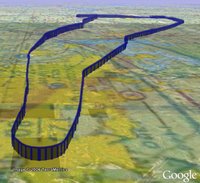
Nate had come home from Spring Break with a brand new Student Pilot's certificate for a Sailplane. Now he wanted to compare what he had learned with powered flight. Well, any excuse to fly sounds good to me.
Objectives of this flight: VFR flight rules, touch and goes, and radio communications.
Cold fronts have still been passing through Georgia stirring up the air. Ceiling and visibility was great, but preflight planning showed winds were gusting up to 20 kts with nearly 90 degree (variable) crosswinds. Forecast was for the winds to subside later in the day.
We arrived at the airport about 6:00pm local. The plane was already back from a previous flight so we were able to get the dispatch kit and start the preflight almost immediately. I took some time to brief him on the plan. He would handle the radio with ground/tower, and after takeoff fly to the Rome VOR. Enter the pattern trough the ILS approach, do some bounces, depart and get vectors to the ILS back home with a night landing.
Taxi and runup all normal. His communications work was good. (Listening on his transceiver over the past few months definitely helped.) The pattern was busy for a Sunday afternoon and Tower was able to squeeze us in for takeoff just in front traffic on base. He made a nice takeoff with a gusting right crosswind and climbed to 4500 on course to the VOR. The expected turbulence was nil. Since this was a VFR flight, I had him get outside reference and told him to fly just left (south) of the cooling towers at Cartersville. (I never realized that this is a coal powered generating plant.)

I explained 'AMICEATM' and set him up for the ILS 01 at KRMG. He had flown this on MS Flight Simulator, so thought this would enable him to make a nice comparison. I walked him though the parallel entry, timing and intercept for the final approach course. The whole time I was talking to traffic. Two other planes were using Rome, one in the pattern and one on a VOR approach behind us. No factor, but I relaxed once we all saw each other. Having a landing light on at dusk really helps. He did a nice job all the way down.
I knew it was a left hand pattern, but what was the pattern altitude? (Note to self; check this in the Airport Directory BEFORE getting into the pattern.) I guessed at about 1100 ft (missed approach height), it turned out to be 1440 ft, so obviously the first approach was low. Corrected to 1500 ft for the next orbit which worked well. Finally, he had learned to do slips in the sailplane, so I flew a high (+300 ft) approach and slipped it in for him. Not as dramatic as a sailplane, but effective. Departed the pattern and headed for home.
It was full night time now and as always, beautiful. Cartersville passed under our right wing and the air was smooth as glass. Nate did a good job of maintaining 3500 ft as I dialed up Atlanta Approach to see if we could get vectors. Ran into a minor problem here, as the GPS display was dimming too far. When I pointed my flashlight on the sensor I could get it bright enough, but then in would automatically dim back to a low level. While this works, it was distracting so I asked the chief pilot about when we got back to the school. One fix it to go to the last AUX page, select Display, and go from AUTO to MANUAL with the small knob.
 "Squawk 0123 (did I hear that right?) maintain 3500 and fly heading 110." Nate flew and I did the readbacks. Nice smooth turns and good airwork on the ILS. Cleared to land #2 behind a Caravan. No problems. A great evening flight. We went 149 miles, got up to 4747 feet and a max ground speed of 147 mph, and we had fun.
"Squawk 0123 (did I hear that right?) maintain 3500 and fly heading 110." Nate flew and I did the readbacks. Nice smooth turns and good airwork on the ILS. Cleared to land #2 behind a Caravan. No problems. A great evening flight. We went 149 miles, got up to 4747 feet and a max ground speed of 147 mph, and we had fun.C172p
Time = 1.6

1 comment:
Dave, How do you make those cool Google images showing the flight path?
Post a Comment